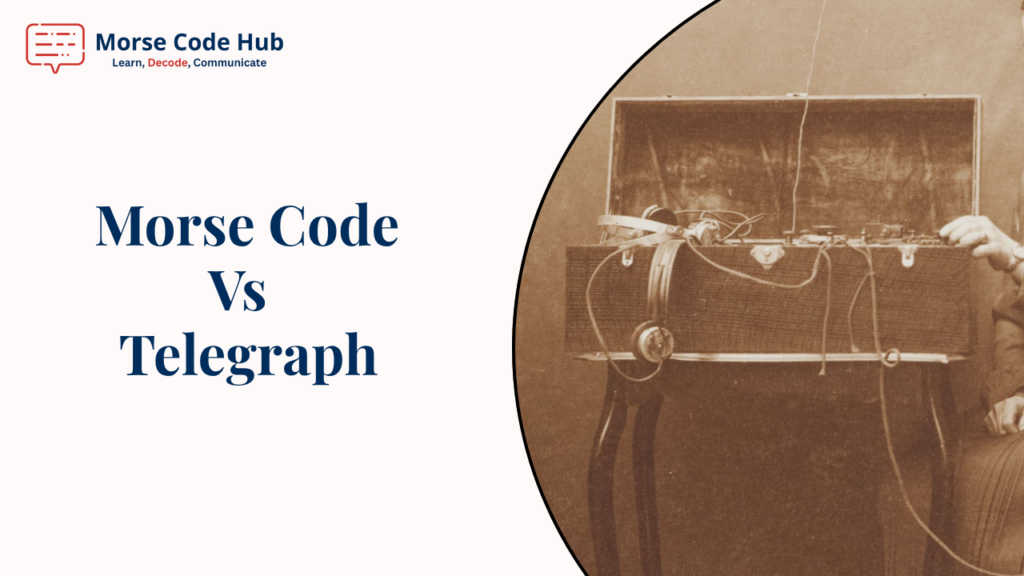The debate of Morse code vs. telegraph often sparks curiosity among communication enthusiasts, as these two innovations reshaped how we connect across distances. As a Morse code aficionado who’s spent years decoding dits and dahs, I find their intertwined history endlessly fascinating. Morse code, a system of dots and dashes, served as the language of the telegraph, a device that transmitted electrical signals over wires. This article explores their mechanics, differences, and lasting impact, drawing on historical insights and modern relevance. With tools on Morse Code Hub, you can experiment with Morse code in languages from Latin to Japanese, bringing this legacy to life.
What Is Morse Code and How Does It Work?
Morse code is a method of encoding text characters using sequences of short and long signals, known as dots (•) and dashes (–), or “dits” and “dahs” when spoken. Invented by Samuel F.B. Morse and Alfred Vail in the 1830s, it assigns unique patterns to letters, numbers, and punctuation. For example, “A” is •– (dit-dah), and “SOS” is ••• ––– ••• (dit-dit-dit dah-dah-dah dit-dit-dit). Morse code’s simplicity allowed complex messages to travel vast distances via electrical pulses.
The system relies on timing: a dot is one time unit, a dash is three, with one-dot pauses between elements of a letter, three-dot pauses between letters, and seven-dot pauses between words. By 1865, the International Morse Code, refined by Friedrich Clemens Gerke, standardized these patterns globally, as per Wikipedia. Encode “HELLO” with our Morse code translator to experience its rhythmic flow.
The Telegraph: A Game-Changer in Communication
The telegraph, a device for sending coded signals over long distances, revolutionized communication in the mid-19th century. Developed by Samuel Morse, Alfred Vail, and others, it used electrical pulses to transmit messages via wires, outpacing horse couriers and semaphore systems. On May 24, 1844, Morse sent the first message, “What Hath God Wrought,” from Washington, D.C., to Baltimore, covering 38 miles in seconds.
Early telegraphs used a key to send pulses, a receiver to record them as dots and dashes on paper tape, later replaced by audible clicks. By 1861, Western Union’s transcontinental telegraph line spanned the U.S., connecting over 50,000 miles of wire. The telegraph’s infrastructure laid the backbone for modern telecommunications, from telephones to the internet.
Morse Code as the Language of the Telegraph
Morse code was the telegraph’s essential language, translating human thoughts into electrical signals. Each letter’s dot-and-dash pattern was tapped on a telegraph key, sending pulses through wires to a receiver converted into clicks or marks.
Initially, Morse’s American code included pauses and was used on U.S. landlines, but the International Morse Code, adopted in 1865, streamlined it for global use, especially for non-English alphabets with diacritics noted by Britannica. By 1900, 95% of maritime communications relied on Morse code via telegraphy, ensuring clarity in distress signals like SOS, as per World History Edu. Operators memorized the code’s rhythms, transcribing messages in real time. Try encoding phrases like “TELEGRAPH” with our words in Morse code tool to feel this synergy.
Key Differences Between Morse Code and Telegraph
While intertwined, Morse code and the telegraph are distinct. The telegraph is the physical device—a system of wires, keys, batteries, and receivers—that transmits electrical signals. Morse code is the encoding method, the “software” that gives those signals meaning.
- Function: The telegraph sends and receives pulses; Morse code defines their patterns (e.g., ••• for “S”).
- Medium: Telegraphs initially used wires, later radio waves, while Morse code works across mediums like sound, light, or blinks.
- Operation: Telegraphs require hardware (keys, sounders); Morse code needs only a trained operator or decoder.
- Scope: Morse code can be used without a telegraph, as in visual signaling, while telegraphs rely on a coding system like Morse.
By 1851, over 50 U.S. telegraph companies used Morse code exclusively, handling 90% of wired communications, noted by Britannica. This distinction highlights their complementary roles in revolutionizing messaging. Explore Morse code’s patterns with our numbers in Morse code tool to see its versatility.
Technological Evolution: From Wires to Wireless
The telegraph and Morse code evolved dramatically, transitioning from wired to wireless systems. Early telegraphs, like Morse’s 1844 line, relied on copper wires, but by the 1890s, Guglielmo Marconi’s radiotelegraphy used Morse code over radio waves.
Wireless telegraphy, using Morse code, dominated early 20th-century maritime and military communication. During World War II, 80% of Allied naval signals used Morse code via radio telegraphs, as per a 2023 Military.com article Military.com. Meanwhile, Morse code adapted to new mediums, from blinker lights to satellite signals, showcasing its resilience. Experiment with wireless-era codes using our Morse code translator.
Legacy and Relevance in Today’s Digital Age
The telegraph’s legacy lies in its role as the precursor to modern telecommunications, while Morse code endures in niche but vital applications. In emergencies, Morse code’s simplicity shines. The U.S. Navy still trains specialists in Morse for backup communication, with 60% of trainees mastering it in six weeks, as per HowStuffWorks. Culturally, Morse code appears in music and films, like Rush’s “YYZ” (–•–– –•–– –••). Encode modern terms like “DIGITAL” with our words in the Morse code tool to connect with its legacy.
The telegraph faded by the 1980s, replaced by digital systems, but its impact endures in global connectivity. Morse code, however, persists, taught to scouts and used in covert signaling, as seen in POW Jeremiah Denton’s 1966 blinked “TORTURE” message. In 2025, both remind us how simple innovations can transform the world.
Conclusion
In the Morse code vs. telegraph story, Morse code is the language that gave the telegraph its voice, together with revolutionizing communication. The telegraph’s wires built the first global networks, while Morse code’s adaptability spans wires, radio, and beyond. Dive into this history with Morse Code Hub tools, and tap out a message to honor 2025’s enduring legacy of dots and dashes.



